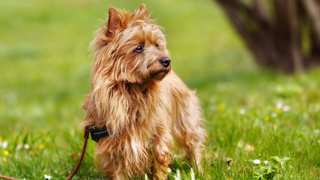Australian Terrier history can be traced to 1820 when the development of the breed began in Tasmania, a large island south of Australia. These dogs were initially called Rough Coated Terriers. Although they have a kinship to the then-popular Scotch Dog that was popular in the region, the Australian Terrier ultimately came from cross-breeding a number of dog breeds. Among those used were the Cairn Terrier, the Dandie Dinmont Terrier, the Irish Terrier, the Shorthaired Skye Terrier, and the Yorkshire Terrier. There may have been other breeds from Scotland used, namely the Manchester (previously called the Black-and-Tan), the Norwich, and the Scottish Terriers. By the 1850s, the Rough Coated Terrier was itself a popular breed in Tasmania.
Just as many Terrier breeds were known to produce this feisty little ratter and snake-catcher, so too did this breed have many names in the first few decades. Before a formal breed name was made, these dogs were informally called the "broken-coated terrier of blackish blue sheen." Some of the breed's early monikers were Blue and Tan Terrier and the Toy. Nearly a century later (in 1900), some people still called it the "Rough-Coated Terrier, Blue and Tan."
In 1896, the Rough Coated Terrier breed was re-named the Australian Terrier, and the breed standard was established too. It wasn't long before these dogs were being taken north to the "mainland," Australia. A 1906 dog show held in Melbourne was when this nearly century-old breed was first shown. Back in England, the dog was also being introduced to the dog show circuit. Still, it took a few decades before they were fully acknowledged. In 1933, The Kennel Club formally recognized the Australian Terrier.
In America, this hard-working little range dog took even longer to be understood, apparently. They were said to have first arrived around 1925. The American Kennel Club finally recognized the dogs in 1960. In 1970, the United Kennel Club followed suit.

